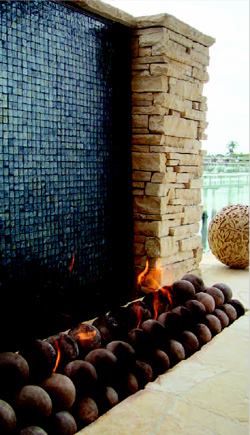Whenever you design your own water source, be sure to balance the supply of water to the pipe, just as you would to spa jets, says Jim Mowry, owner of Master Pools of Austin/Mowry Pools in Austin, Texas. Introduce water in more than one area so it is evenly distributed. This is especially important for wider walls: You don’t want the water to flow more heavily down one side of the wall.
Obviously, the water feature will need some kind of container to catch the flow at the bottom of the wall. This basin’s size and configuration will depend on water volume and splash out. For low-flow installations, water can slide through a 3- to 4-inch-wide notch in the ground into a concrete holding tank or even a large pipe. But if the water feature creates any kind of splash, it will need a catch basin that projects at least 1 foot from the wall, says Ron Gibbons, president of Ron Gibbons Swimming Pools in Islip Terrace, N.Y. When creating a basin, always make sure it’s at least 1 foot deep to prevent vortexing at the drains.
These water features have a huge surface-to-air ratio, so outfit them with auto-fills to make up for evaporation loss. Be sure to waterproof both the catch basin and the back of the wall. This prevents additional water loss and keeps the back of the water feature clean and attractive. “Sometimes people can see the back of the wall,” Gibbons says. “So it’s good to waterproof the back really well.”
Always sanitize the water if possible. This prevents algae from forming on the wall.
The Wall. In order to create the desired effect, remember that the wall itself is just as important as the water, and must be properly designed and built.
Water may fall right off a surface that is too vertical, so be sure to cant the wall back a bit. For the thinnest, subtlest sheets the angle can be very small—about 3 to 4 degrees, according to Gibbons. This will serve the purpose and can’t be detected by the human eye. For more turbulent water, or a larger flow, Sargent slants his walls back 1 inch per foot of height. “The more water you send down the wall, the more it’s going to try to sheet,” he says.
The face of the wall can be veneered with any range of materials, from smooth glass tile and polished stone to deliberately rough surfaces. Some builders even use stacked or notched stone to add texture to the water.
Start with materials that are hard enough to withstand exposure to chemically treated water over the course of many years. It’s a good idea to bypass softer stones such as limestone and slates. This principle is so important that Sargent will refuse to warranty softer materials when the designer or homeowner insists on using them. Polished granite is a good option. When using this, Sargent says, explain to clients that it will need occasional restoring to maintain the gloss.
If you want a smooth appearance, use materials with as few joints as possible. This offers the cleanest look, and helps prevent turbulence and leaching from the grout.
If you’re trying to create a clean look with very low flow of water, go with darker-colored materials, Gibbons advises. “When you use a white, tan, or beige color, you can’t see the water,” he says. “But if you use a dark brown or black, you can really see it foaming and falling down. I learned that through experience.”



